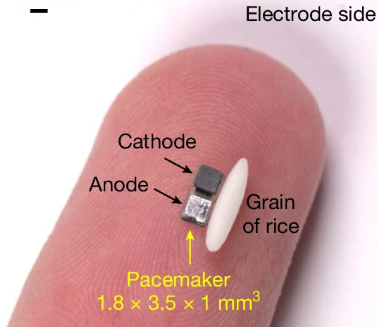
A pacemaker that’s smaller than a grain of rice and can be injected into the heart through the skin, without the need for surgery, has been invented by scientists.
Pacemakers use electric pulses to steady heartbeats and protect the organ against potentially fatal abnormal rhythms.
The small device is typically about the size of a matchbox and weighs about 20 to 50g. It consists of a pulse generator, which has a battery and a tiny computer circuit, and one or more wires known as pacing leads, which attach to your heart.
But at just 1.8mm wide, 3.5mm long and 1mm thick, researchers at Northwestern University in Illinois, US, have developed one that is smaller than a grain of rice.

The pacemaker has no wires and does not need to be removed at a later date because it dissolves.
A study published in the journal Nature found the miniature pacemaker worked well in mice and rats and successfully corrected abnormalities in heart rhythm.
Scientists came up with the invention while searching for a way to monitor the hearts of babies who had undergone life-saving cardiac surgery.
“Our major motivation was children,” cardiologist Igor Efimov, who co-authored the study, told science publication IBSA Foundation.
“About 1 per cent of children are born with congenital heart defects, [and often] in about seven days or so [of temporary stimulation], most patients’ hearts will self-repair. But those seven days are absolutely critical.”
Affecting one in 100 babies born in the UK, those with a congenital heart defect may need surgery before being fitted with a temporary pacemaker to monitor heart rhythm. It is then removed again at a later date.
But surgery is risky and can lead to infection, lacerations and perforations.
However, with this new pacemaker, the risk of life-threatening complications is reduced because it is small enough to fit into a syringe and can be inserted without the need for surgery.
The mini pacemaker is made with two electrodes of different metals, which, when in contact with the body’s fluids, generate an electrical current capable of stimulating the heart when needed.
Its soft and flexible structure also means it can fit onto the heart wall without the need for invasive stitches.
Researchers hope the device will open up new possibilities for cardiologists, including being able to give patients several pacemakers at once, enabling them to control single areas of the heart.
However, these small pacemakers are not intended to replace permanent ones in patients with chronic heart rhythm problems who need them for life.
EPA eliminates research and development office, begins layoffs
What is chronic venous insufficiency? Symptoms after Trump diagnosed with condition
Weight loss surgery tourism needs urgent regulation, experts say
UK admits foreign aid cuts could see deaths rise – with Africa hit hardest
How much resident doctors really earn as they plan to strike over NHS pay







